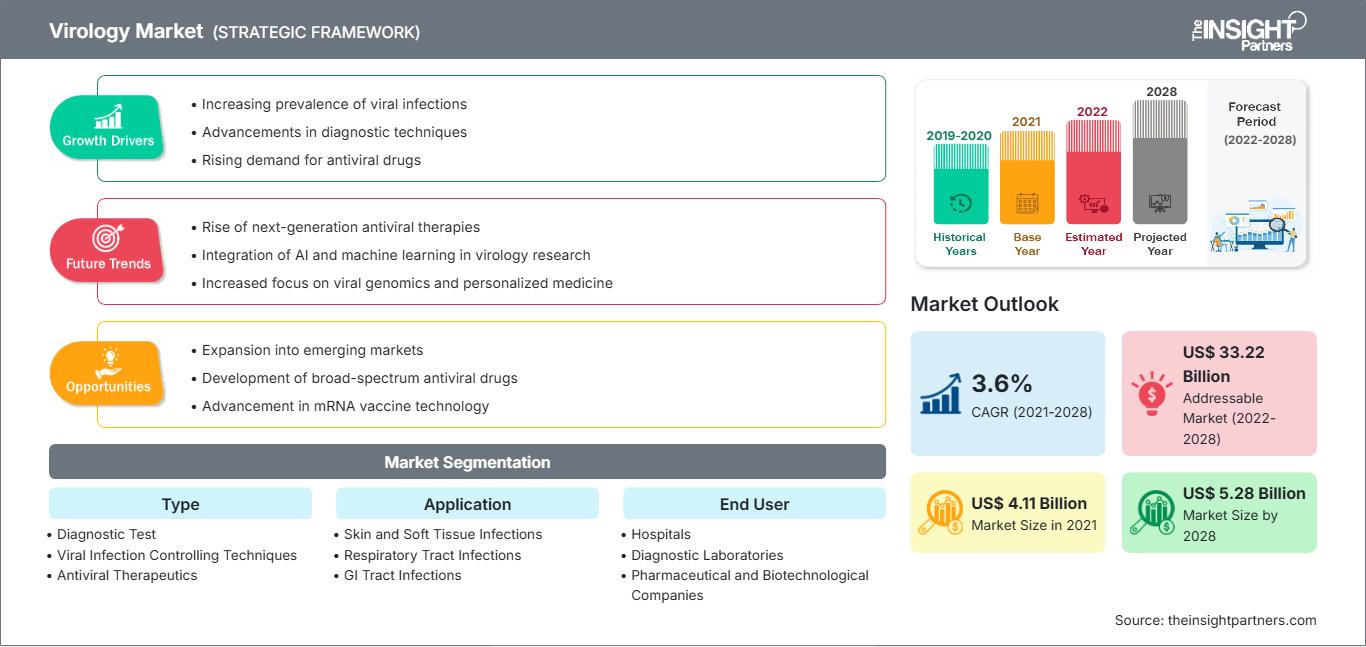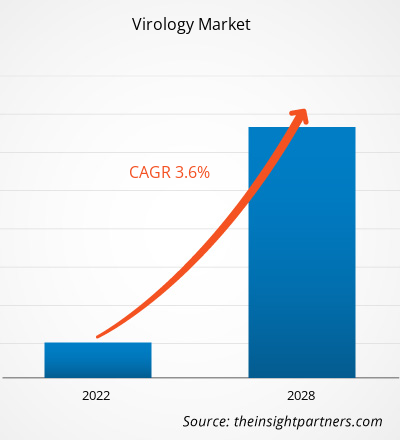页面已更新 :
Jun 2024
病毒学市场规模预计将从2021年的41.0827亿美元增至2028年的52.7648亿美元;预计2021年至2028年的复合年增长率为3.6%。
病毒学是医疗保健体系的重要组成部分,广泛应用于疫苗研发、诊断、治疗等领域。病毒学市场参与者不断参与产品创新和开发,以保持市场竞争力。他们探索各种产品创新领域。例如,针对COVID-19,市场参与者正在大力投资疫苗、检测试剂盒以及其他相关产品和服务的开发。以下是与病毒学市场相关的一些市场动态。
- 2021年8月,美国食品药品监督管理局 (FDA) 批准了首款新冠疫苗,即辉瑞-BioNTech 新冠疫苗。该疫苗将以 ComiRNAty(Koe-mir'-na-tee)的名称上市。该疫苗旨在预防16岁及以上人群感染新冠。它也可在紧急使用授权 (EUA) 下使用。
- 2021 年 4 月,CerTest Biotec 推出了用于 BD MAX 系统的 CE 标志 COVID-19 诊断测试。
- 2020 年 5 月,Bio-Rad 获得 FDA 批准,可获得 COVID-19 总抗体测试的紧急使用授权。
- 2020 年 5 月,Aalto Bio Reagents 推出了新型重组真核 SARS-CoV-2 S1-S2 刺突蛋白。
因此,市场参与者通过产品创新和不同国家的政府支持积极参与,促进了病毒学市场的增长。
自定义此报告以满足您的要求
您将免费获得任何报告的定制,包括本报告的部分内容,或国家级分析、Excel 数据包,以及为初创企业和大学提供超值优惠和折扣
病毒学市场: 战略洞察

- 获取本报告的主要市场趋势。这个免费样本将包括数据分析,从市场趋势到估计和预测。
自定义此报告以满足您的要求
您将免费获得任何报告的定制,包括本报告的部分内容,或国家级分析、Excel 数据包,以及为初创企业和大学提供超值优惠和折扣
病毒学市场: 战略洞察

- 获取本报告的主要市场趋势。这个免费样本将包括数据分析,从市场趋势到估计和预测。
市场洞察
微创和非侵入性美容手术的日益普及推动了病毒学市场的增长
人类免疫缺陷病毒 (HIV)、流感病毒、寨卡病毒、埃博拉病毒、SARS-CoV-2 和脊髓灰质炎病毒等病毒感染了世界各地的大量人口。随着病毒不断变异和进化,耐药性成为人类和动物病毒感染管理的一大挑战。病毒通过基于其类型的各种媒介传播。例如,一些病毒会引起呼吸道病毒性疾病,如流感、普通感冒和呼吸道合胞病毒感染,它们通过咳嗽或打喷嚏产生的飞沫传播,而一些胃肠道病毒性疾病则通过直接接触感染者的粪便或通过受污染的食物或水传播。根据联合国艾滋病规划署全球艾滋病毒和艾滋病统计数据显示,2020 年全球有超过 3770 万人感染艾滋病毒。
国际病毒分类委员会 (ICTV) 于 2020 年 2 月将导致 COVID-19 的新型冠状病毒宣布为严重急性呼吸道综合征冠状病毒 2 (SARS-CoV-2)。自爆发以来,该病毒已发生数次变异,这加剧了 COVID-19 疫情的严重性。例如,根据美国疾病控制与预防中心 (CDC) 的 COVID-19 追踪数据,截至 2021 年 8 月,美国每 100,000 人的七天发病率为 299.4,新增病例超过 164,952 例。此外,根据欧洲疾病预防控制中心的数据,截至 2021 年 8 月,欧洲经济区 (EEA) 的 COVID-19 病例总数已达到 ~36,307,572 例。因此,病毒感染的流行率不断上升正在推动病毒学市场的增长。
病毒学市场
The Insight Partners 的分析师已详尽阐述了预测期内影响病毒学市场的区域趋势和因素。本节还讨论了北美、欧洲、亚太地区、中东和非洲以及南美和中美洲的病毒学市场细分和地域分布。
病毒学市场报告范围
病毒学市场参与者密度:了解其对商业动态的影响
病毒学市场正在快速增长,这得益于终端用户需求的不断增长,而这些需求的驱动因素包括消费者偏好的演变、技术进步以及对产品优势的认知度的提升。随着需求的增长,企业正在扩展产品线,不断创新以满足消费者需求,并抓住新兴趋势,从而进一步推动市场增长。

- 获取 病毒学市场 主要参与者概述
基于类型的洞察
根据类型,病毒学市场进一步细分为诊断检测、病毒感染控制技术、抗病毒疗法和干扰素。预计到2021年,诊断检测领域将占据最大的市场份额,而病毒感染控制技术领域预计将在2021年至2028年期间实现最高的复合年增长率。
基于应用的洞察
根据应用,市场细分为皮肤和软组织感染、呼吸道感染、胃肠道感染、性传播疾病、泌尿道感染等。 2021 年,呼吸道感染领域预计将占据最大的市场份额,预计在 2021 年至 2028 年期间将实现最高的复合年增长率。
在病毒学市场运营的公司强调采用产品创新战略来满足全球不断变化的客户需求,这也使他们能够在全球市场上保持自己的品牌名称。
病毒学市场 –细分
按类型
- 诊断测试
- DNA 病毒检测
- RNA 病毒检测
- 其他
- 病毒感染控制技术
- 主动预防
- 被动预防
- 抗病毒治疗
- 杀病毒剂
- 抗病毒剂
- 免疫调节剂
- 干扰素
按应用
- 皮肤和软组织感染
- 呼吸道感染
- 胃肠道感染
- 性传播疾病
- 泌尿道感染
- 其他
按最终用户
- 医院
- 诊断实验室
- 制药和生物技术公司
- 研究和学术机构
按地理位置
- 北美
- 美国
- 加拿大
- 墨西哥
- 欧洲
- 法国
- 德国
- 意大利
- 英国
- 西班牙
- 欧洲其他地区
- 亚太地区
- 中国
- 印度
- 韩国
- 日本
- 澳大利亚
- 其他地区亚太地区
- 中东和非洲
- 南非
- 沙特阿拉伯
- 阿联酋
- MEA 其他地区
- 南美洲和中美洲
- 巴西
- 阿根廷
- 其他 SCAM 地区
公司简介
- 雅培
- 强生服务公司
- F. Hoffmann-LA Roche Ltd.
- 赛默飞世尔科技公司
- Qiagen
- Illumina, Inc.
- 西门子公司
- 葛兰素史克公司
- 吉利德科学公司, Inc.
- AbbVie, Inc.pyright 名称在各自网站上给出。
- 历史分析(2 年)、基准年、预测(7 年)及复合年增长率
- PEST和SWOT分析
- 市场规模、价值/数量 - 全球、区域、国家
- 行业和竞争格局
- Excel 数据集
近期报告
客户评价
购买理由
- 明智的决策
- 了解市场动态
- 竞争分析
- 客户洞察
- 市场预测
- 风险规避
- 战略规划
- 投资论证
- 识别新兴市场
- 优化营销策略
- 提升运营效率
- 顺应监管趋势
我们的客户































87-673-9708

ISO 9001:2015



 获取免费样品 - 病毒学市场
获取免费样品 - 病毒学市场